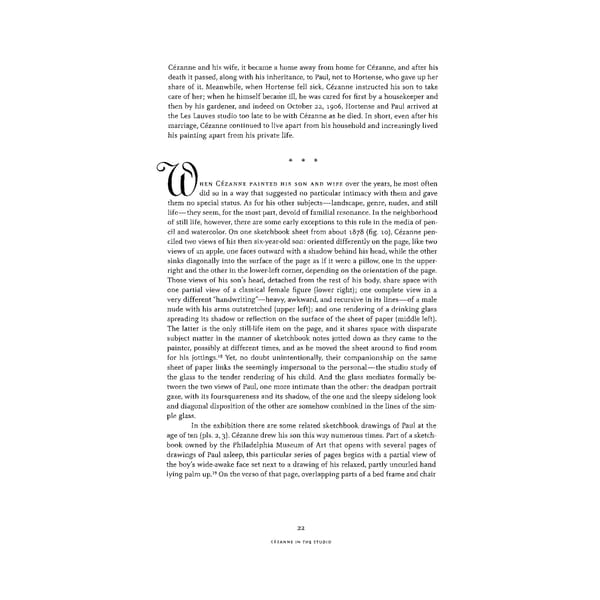Cezanne and his wife, it became a home away from home for Cezanne, and after his death it passed, along with his inheritance, to Paul, not to Hortense, who gave up her share of it. Meanwhile, when Hortense fell sick, Cezanne instructed his son to take care of her; when he himself became ill, he was cared for first by a housekeeper and then by his gardener, and indeed on October 22, 1906, Hortense and Paul arrived at the Les Lauves studio too late to be with Cezanne as he died. In short, even after his marriage, Cezanne continued to live apart from his household and increasingly lived his painting apart from his private life. HEN CEZANNE PAINTED HIS SON AND WIFE over the years, he most often W did so in a way that suggested no particular intimacy with them and gave them no special status. As for his other subjects—landscape, genre, nudes, and still life—they seem, for the most part, devoid of familial resonance. In the neighborhood of still life, however, there are some early exceptions to this rule in the media of pen- cil and watercolor. On one sketchbook sheet from about 1878 (fig. 10), Cezanne pen- ciled two views of his then six-year-old son: oriented differently on the page, like two views of an apple, one faces outward with a shadow behind his head, while the other sinks diagonally into the surface of the page as if it were a pillow, one in the upper- right and the other in the lower-left corner, depending on the orientation of the page. Those views of his son's head, detached from the rest of his body, share space with one partial view of a classical female figure (lower right); one complete view in a very different "handwriting"—heavy, awkward, and recursive in its lines—of a male nude with his arms outstretched (upper left); and one rendering of a drinking glass spreading its shadow or reflection on the surface of the sheet of paper (middle left). The latter is the only still-life item on the page, and it shares space with disparate subject matter in the manner of sketchbook notes jotted down as they came to the painter, possibly at different times, and as he moved the sheet around to find room 18 for his jottings. Yet, no doubt unintentionally, their companionship on the same sheet of paper links the seemingly impersonal to the personal—the studio study of the glass to the tender rendering of his child. And the glass mediates formally be- tween the two views of Paul, one more intimate than the other: the deadpan portrait gaze, with its foursquareness and its shadow, of the one and the sleepy sidelong look and diagonal disposition of the other are somehow combined in the lines of the sim- ple glass. In the exhibition there are some related sketchbook drawings of Paul at the age of ten (pis. 2, 3). Cezanne drew his son this way numerous times. Part of a sketch- book owned by the Philadelphia Museum of Art that opens with several pages of drawings of Paul asleep, this particular series of pages begins with a partial view of the boy's wide-awake face set next to a drawing of his relaxed, partly uncurled hand 19 lying palm up. On the verso of that page, overlapping parts of a bed frame and chair 22 CEZANNE IN THE STUDIO
 Cézanne in the Studio: Still Life in Watercolors Page 36 Page 38
Cézanne in the Studio: Still Life in Watercolors Page 36 Page 38